In Malaysia, looking after a cat isn’t as tough as it might seem at first. What usually confuses new owners is the pet food market. There are dozens of brands competing for attention—Royal Canin, ProDiet, Brit Care, and many more—each claiming to be the healthiest option. With so many advertisements pushing different products, it’s easy to feel lost. But choosing the right food doesn’t have to be stressful. What matters most is finding something that’s safe, nutritious, and convenient to buy online whenever you need it. Based on my own experience, I’ll share a few tips that can guide you in picking the best diet for your cat, so you can focus on enjoying life with your furry friend instead of worrying about what’s in their bowl.
Introduction
That’s exactly what this guide is for. You’ll find a simple, Malaysia-focused checklist that helps you choose cat food with confidence:
✅ How to quickly read labels (no science degree needed)
✅ Which nutrients matter most for kittens, adult cats, and seniors
✅ Smart storage tips for Malaysia’s hot and humid weather
✅ A “Shopee & Lazada cat food checklist” to avoid counterfeits and low-quality brands
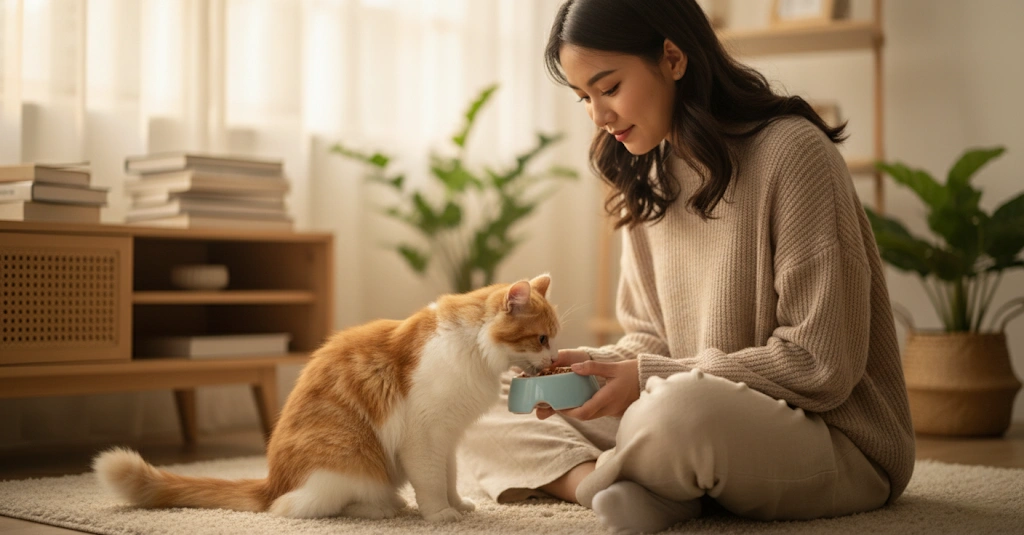
Why Cat Food & Nutrition Matter in 2025
- Indoor lifestyle → Most Malaysian cats live in condos, which means food—not exercise—decides whether they stay healthy or overweight.
- Imported & online shopping → With cat food Malaysia heavily dominated by international brands, buying from Shopee or Lazada is super convenient. But it also makes reading labels and spotting fake products more important than ever.
- Hot, humid climate → Leaving kibble in the kitchen or balcony can reduce freshness and nutrition faster than you think.
👉 In the end, you won’t just know what to buy—you’ll also feel confident that your cat’s bowl is filled with real nutrition, not just empty fillers.
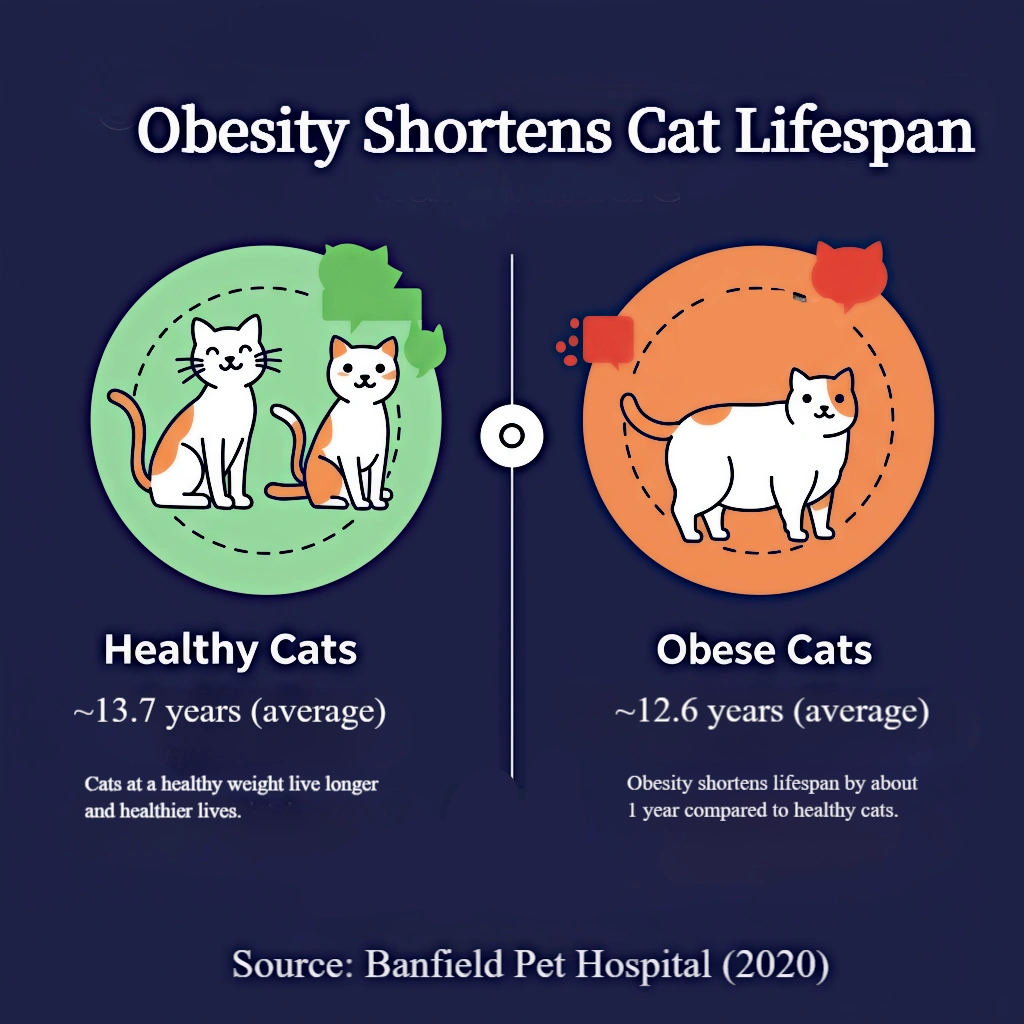
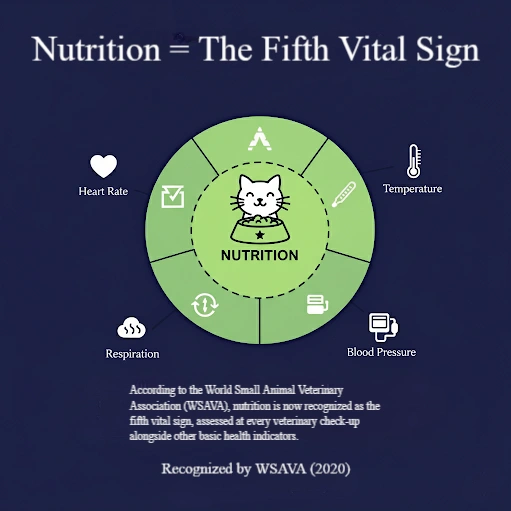
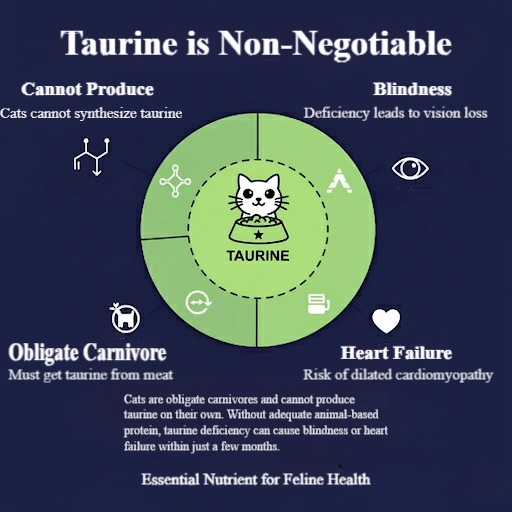
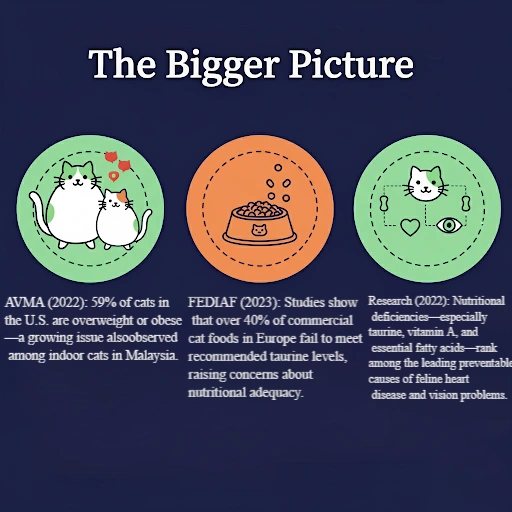
Quick Overview of Expert Feeding Tips
Cat obesity is not just an appearance issue—it shortens lifespan. Data from Banfield Pet Hospital shows that severely overweight cats live about 12.6 years, compared to 13.7 years for cats with an ideal body weight.
Cat nutrition is now recognized as a key component of overall health. The World Small Animal Veterinary Association (WSAVA) even describes it as the “fifth vital sign” in every veterinary check-up.
For cats, taurine deficiency is especially dangerous. As obligate carnivores, they cannot synthesize taurine on their own. A diet lacking this nutrient can lead to blindness and heart failure.
Global data confirms the urgent need for appropriate cat food and nutrition.
- The AVMA Pet Obesity Report (2024) found that 59% of U.S. cats are overweight or obese, a trend now affecting many indoor cats in Malaysia.
- FEDIAF (2023) revealed that over 40% of commercial cat food in Europe fails to meet taurine adequacy.
- PubMed (2022) reports that nutritional deficiencies—especially taurine, vitamin A, and fatty acids—rank among the top three preventable causes of feline heart disease and vision problems.
A Guide to Cat Food in Malaysia
Locally, these brands stand out because of their transparent ingredients and balanced nutrition.
| Brand | Why It Matters |
|---|---|
| Equilibrio Malaysia | Premium cat food brand in Malaysia with formulas for kittens & adults. Contains taurine, probiotics, urinary pH balance, and is AAFCO-certified for complete feline nutrition.Equilibrio Malaysia official site |
| Me-O (Perfect Companion) | One of the most popular cat food brands in Malaysia, rich in taurine, Omega 3 & 6 fatty acids, and low-sodium recipes to support urinary tract health. (perfectcompanion.com.my) |
| Qucing.my | Malaysia-based brand offering salmon-rich cat food with DHA, taurine, and omega fatty acids. Marketed as 100% nutritionally balanced—ideal for both kittens and adult cats. (qucing.my) |
| Budget options (MISHA / ProDiet) | Affordable cat food options in Malaysia, including halal-certified brands like MISHA and ProDiet. Provides good protein & fat balance, making it a trusted choice for many Malaysian households. (oyen.my) |
Quick Tip: How to Read Cat Food Labels
Don’t just look at price or brand name—learn to read the Guaranteed Analysis section on every pack. Here’s what to check:
- Taurine
- Should be clearly listed.
- Minimum: 0.1% (dry food), 0.2% (wet food).
- Prevents heart disease (DCM) and blindness.
- Probiotics
- Look for Lactobacillus or Enterococcus.
- Supports digestion, reduces diarrhea, boosts immunity.
- Bonus if it says “live cultures”.
- Urinary pH
- Ideal range: 6.0–6.5.
- Helps reduce the risk of stones and urinary tract infections.
- Especially important for indoor or neutered cats.
👉 Pro Tip: Brands like Equilibrio Malaysia clearly state taurine levels and urinary support on their labels—always check before you buy.
What’s Inside This Guide
Whether you’re raising a playful kitten, supporting an active adult, or caring for a senior, this guide blends AAFCO & FEDIAF standards, veterinary research, and practical Malaysian examples—so you can confidently choose the best cat food in Malaysia and give your feline the long, healthy life she deserves.
Table of Contents
1. Introduction
- Why Cat Food & Nutrition Matter in 2025
- Quick Overview of Expert Feeding Tips
- A Guide to Cat Food in Malaysia
- Quick Tip: How to Read Cat Food Labels
2. Cat Food Nutrition Guide: AAFCO Standards Every Owner Should Know
- Key Nutrients Every Cat Needs to Stay Healthy
- Friendly Tips for Malaysian Cat Owners
- Why Cat Nutrition Matters
- What This Means for Cat Owners in Malaysia
- Why Cat Nutrition Matters
3. Cat Food Comparison: Dry, Wet, Raw, and Homemade
- Types of Cat Food: Dry, Wet, Raw, and Homemade
- Quick Snapshot
- Raw Diet for Cats: Safety, Pros & Cons
4. Cat Feeding Guide by Life Stage: Kitten, Adult & Senior
- Kitten Nutrition (0–12 Months): Growth & Development
- Adult Cat Nutrition (1–7 Years): Energy & Maintenance
- Senior Cat Nutrition (7+ Years): Aging & Health Support
5. Sensitive Stomach Cat Food (Malaysia)
- Sensitive Stomach & Digestive Support
- Urinary Health Diets: Preventing Stones & Infections
- Food Allergies & Skin Issues
- Obesity & Weight Control Diets for Cats
- Normal vs Veterinary Diets
- Vet Guidance for Special Cat Diets
6. How to Read Cat Food Labels
- Key Things to Check on Cat Food Labels
- How to Read Cat Food Labels in Malaysia
- 1.Guaranteed Analysis (GA) – Protein, Fat, Fiber, Moisture
- 2. Nutritional Adequacy Statement – “Complete & Balanced”
- 3. Ingredient List – What Really Matters
- 4. Cat Food Marketing Claims in Malaysia – Reality Check
- 5. Calorie Content – Feeding the Right Amount
- 6. Quick Label Checklist for Malaysian Cat Owners
- Key Takeaway for Malaysia
7. Cat Feeding Guide Malaysia: Calories, Portions & Practical Tips
- 1.How Many Calories Does a Cat Need Daily?
- 2.How Many Times Should You Feed Your Cat Per Day?
- 3.How to Change Cat Food Safely (7–10 Days)
- 4.How to Check If Your Cat Is Overweight (BCS Scale)
- 5.Hydration & Feeding Environment
- Key Takeaways for Malaysian Cat Owners
8. FAQs About Cat Food & Nutrition
- Can cats eat dog food in Our country?? → “Can Cats Safely Eat Dog Food?”
- Can cats in Our country be vegetarian or vegan? → “Is a Vegetarian Diet Safe for Cats?”
- Can cats drink milk in Malaysia’s tropical climate?→ “Can Cats Drink Milk Without Issues?”
- How often should I feed my cat in Our country? → “Feeding Frequency: How Often Should You Feed Cats?”
- How do I know if cat food is good quality in Malaysia?→ “Best Food Options for Picky Cats”
9. Conclusion & Next Steps
- What You Can Do Next
Cat Food Nutrition Guide: AAFCO Standards Every Owner Should Know

Key Nutrients Every Cat Needs to Stay Healthy
Cats need high protein, taurine, healthy fats, vitamins, and plenty of water to stay active and disease-free. In Malaysia’s hot climate, hydration is just as important as food choice — especially for female cat owners concerned about urinary health and a shiny coat.
| Nutrient (Dry Matter Basis) | Minimum Requirement | Why It Matters |
|---|---|---|
| Crude Protein | ≥ 26% (Adult) / ≥ 30% (Kitten) | Supports muscle growth, tissue repair |
| Taurine | ≥ 0.10% (Dry) / ≥ 0.20% (Canned) | Prevents blindness, heart disease |
| Fat (Essential Fatty Acids) | ≥ 9% | Provides energy, supports skin & coat |
| Calcium : Phosphorus Ratio | 1.0–1.5 : 1 | Ensures bone and dental health |
| Vitamin A | ≥ 9000 IU/kg | Cats cannot convert beta-carotene |
| Vitamin D | ≥ 750 IU/kg | Regulates calcium absorption, bone growth |
| Arginine | ≥ 1% | Prevents toxic ammonia buildup |
| Water Intake | 50–70 ml/kg/day | Essential for urinary tract & kidney health |
Friendly Tips for Malaysian Cat Owners
- Hydration in a hot climate: Malaysia’s warm weather makes hydration extra important. Even if your cat eats dry food, always provide fresh water or try adding wet food to prevent urinary tract issues — something female cat owners often worry about.
- Skin & Coat Beauty: Many women notice their cat’s coat first. Adequate fat and Vitamin A support shiny fur, which is a sign of health.
- Kitten vs Adult Needs: Kittens need higher protein (≥30%) for growth. Adult cats can stay healthy with ≥26%, but always check the label before buying.
- Smart Shopping Tip: Look for “Complete & Balanced” on cat food packaging in Malaysia. This phrase means the food meets AAFCO or FEDIAF standards.
Why Cat Nutrition Matters
It’s more than just food. Good cat nutrition is the cornerstone of preventive healthcare. As obligate carnivores, cats need key nutrients found in animal protein to thrive. Malaysian cat parents, your choice of cat diet today can make all the difference tomorrow.
If these nutrients are missing, the effects may not show immediately. But over time, poor nutrition can cause serious and irreversible health issues like blindness, heart disease, or kidney problems.
📊 According to AAFCO and FEDIAF standards, even small nutrient gaps can have major effects. Taurine deficiency, for example, has been directly linked to heart disease in cats (Pion et al., Science, 1987). On the other hand, excess calories are the #1 cause of obesity—a rising issue not only in the US (60% of indoor cats, APPA 2024) but also reported increasingly by veterinarians in Malaysia and Singapore.
What This Means for Cat Owners in Malaysia
- Choose AAFCO or FEDIAF-compliant food – when buying makanan kucing in Malaysia (dry food, wet food, or raw diets), always check the label for compliance.
- Watch the portion size – overfeeding, even with premium brands, leads to obesity.
- Check body condition regularly – if you cannot feel your cat’s ribs easily, it’s time to adjust.
👉 For more practical tips, see our guides:
Why Cat Nutrition Matters
Why Cat Nutrition Matters
Kittens need protein-rich diets for healthy growth, while adult cats on carb-heavy food risk obesity and diabetes. Senior cats often lose appetite, making nutrient-dense and easy-to-digest meals essential. 👉 Check our guides for kitten food, senior cat nutrition, and sensitive stomach diets.
💡 Quick tip for cat moms: warming wet food can boost aroma and tempt picky eaters.
- Dry cat food (kibble): Affordable and convenient, but cats on dry-only diets may drink too little water—raising the risk of urinary problems.
- Wet cat food: Rich in moisture and often more appetizing. Great for hydration and picky eaters, though it may cost more and require extra dental care.
- Raw cat food: Popular for its “natural feeding” appeal, but carries bacterial risks (like Salmonella, E. coli) that can affect both cats and owners.
- Homemade cat food: Can feel caring and personal, but studies show most DIY recipes online don’t meet essential nutrition standards—so vet guidance is a must.
💡 Quick Tip for Cat Moms:
If your cat rarely drinks water, adding wet food to her daily meals can help prevent urinary issues.
- Dry Cat Food Pros & Cons
- Best Wet Cat Food Options
- Is Raw Cat Food Safe for Cats?
- Homemade Cat Food: What You Should Know
Cat Food Comparison: Dry, Wet, Raw, and Homemade
Choosing the right diet for your cat can feel overwhelming—dry kibble, wet canned food, raw diets, or homemade meals. Each option has unique pros and cons. This comparison helps you understand the benefits, risks, and best uses, so you can decide with confidence.
| Food Type | Moisture % | Cost (Approx RM / month) | Clinical Benefits | Risks / Limitations | Best For |
|---|---|---|---|---|---|
| Dry Cat Food (Kibble) | ~10% | RM50–100 | Convenient, affordable, may reduce tartar | Low hydration, higher carbs | Busy owners prioritizing cost & convenience |
| Wet Cat Food (Canned) | 75–80% | RM150–300 | Hydration, higher palatability, weight control | More costly, dental plaque risk | Cats prone to urinary/kidney issues |
| Raw Cat Food | 65–70% | RM250–400+ | “Natural” appeal, lean body mass | Pathogen risk, nutrient imbalance | Rare cases, vet-supervised only |
| Homemade Cat Food | Variable | RM200–500+ (depending on ingredients & supplements) | Full ingredient control, customization | Labor-intensive, high deficiency risk | Cats with medical diets (vet formulated) |
💡 Cat Mom Tip:
- If your cat doesn’t like drinking water, wet cat food can help keep her hydrated.
- Raw and homemade cat food may look natural or caring, but without a vet’s guidance, they carry high health risks.
👉 Want details? See our full guides:
The type of cat food matters, but your cat’s life stage decides how much and what balance is needed. A kitten fed only adult food may grow weak, while a senior cat on high-calorie kitten food risks obesity and kidney strain.
💡 Quick Vet Tip:
- Kittens need 2–3× more protein and calories per kg than adults to grow strong bones and muscles.
- Adult cats thrive on balanced meals with controlled portions to prevent weight gain.
- Senior cats often do better with kidney-friendly, phosphorus-controlled diets for long-term health.
👉 In the next section, we’ll guide you through kitten food, adult cat food, and senior cat diets—with practical tips for Malaysian cat parents to choose wisely at local pet shops or online platforms like Shopee and Lazada.
Types of Cat Food: Dry, Wet, Raw, and Homemade
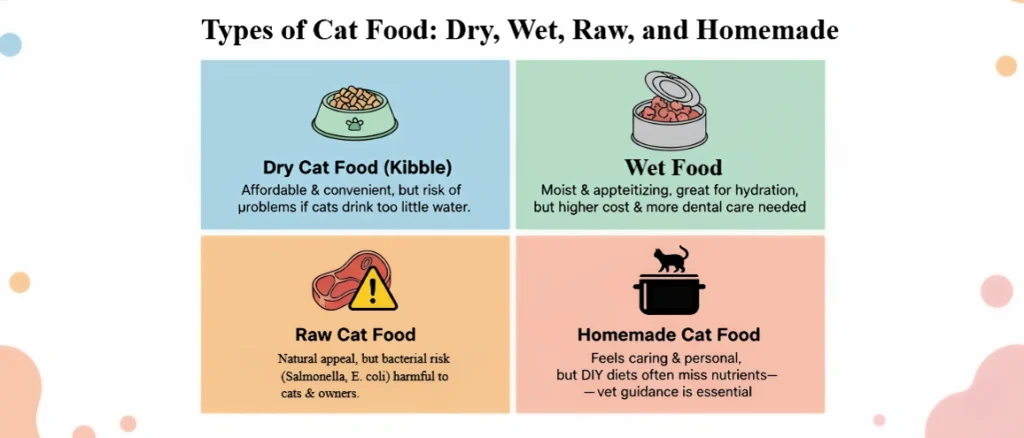
Choosing the right food can feel overwhelming—kibble, canned, raw, or even homemade. Each type of cat food has its own benefits, risks, and trade-offs, so understanding the basics helps you make confident choices.
Quick Snapshot
- Dry cat food (kibble): Affordable and convenient, but cats on dry-only diets may drink too little water—raising the risk of urinary problems.
- Wet cat food: Rich in moisture and often more appetizing. Great for hydration and picky eaters, though it may cost more and require extra dental care.
- Raw cat food: Popular for its “natural feeding” appeal, but carries bacterial risks (like Salmonella, E. coli) that can affect both cats and owners.
- Homemade cat food: Can feel caring and personal, but studies show most DIY recipes online don’t meet essential nutrition standards—so vet guidance is a must.
💡 Quick Tip for Cat Moms:
If your cat rarely drinks water, adding wet food to her daily meals can help prevent urinary issues.
Cats don’t need the same food throughout their lives. Just like babies, teenagers, and seniors have different diets, kittens, adults, and older cats also thrive on age-appropriate meals. Giving the wrong food may cause slow growth in kittens, weight problems in adults, or kidney strain in seniors.
Cat Feeding Guide by Life Stage: Kitten, Adult & Senior
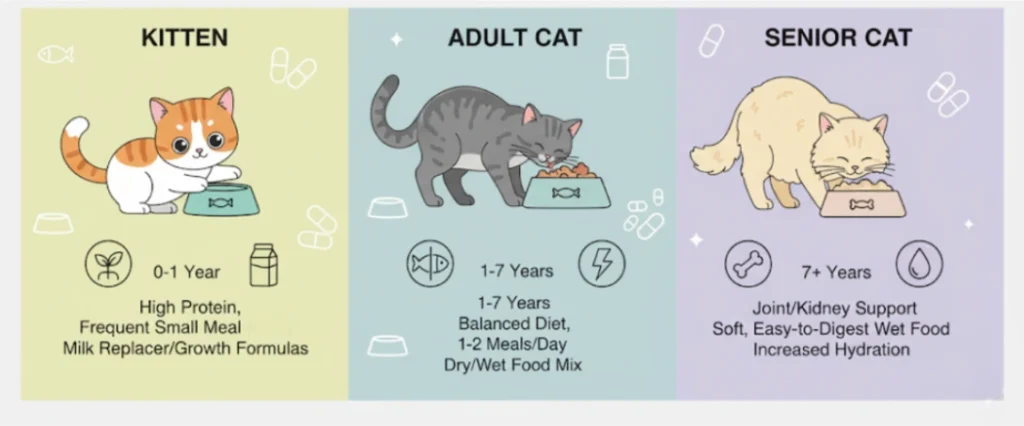
🐾 Kitten Nutrition (0–12 Months): Growth & Development
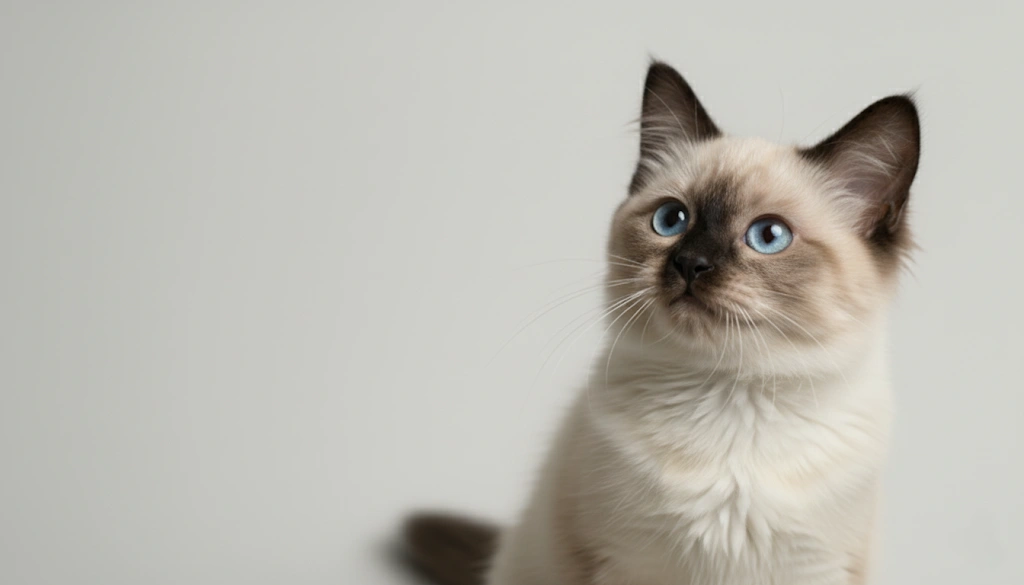
Kittens grow fast, building strong bones, muscles, and immunity. That’s why they need more energy and protein than adult cats.
What to look for in kitten food:
- High protein (animal-based) to fuel growth and play.
- Added DHA for brain and vision development.
- Balanced calcium and phosphorus for healthy bones.
Feeding tips for cat moms:
- Offer 4–5 small meals daily (tiny tummies, big energy).
- Switch to adult food at about 12 months.
- In Malaysia, expect to spend around RM80–150 per month depending on the brand (Whiskas, Cindy’s Recipe, Royal Canin).
🐾 Adult Cat Nutrition (1–7 Years): Energy & Maintenance
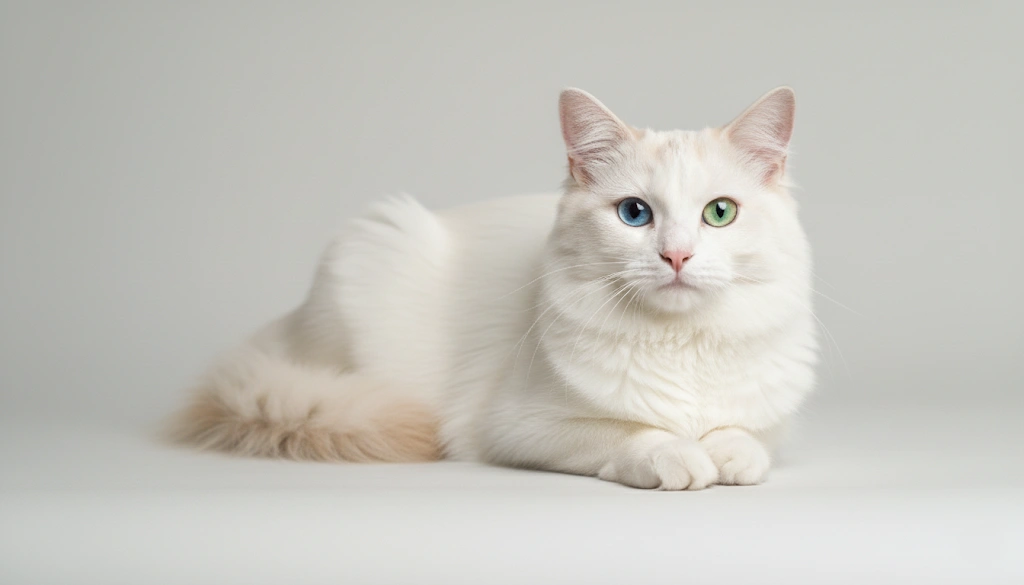
Once cats reach adulthood, the focus shifts to maintaining a healthy weight and preventing lifestyle diseases like diabetes.
Key priorities in adult diets:
- Moderate protein from meat or poultry.
- Balanced fat to avoid obesity.
- Limited carbs to reduce risk of insulin resistance.
- Essential taurine for heart and eye health.
Feeding tips:
- Serve 2–3 meals a day, not free-feeding.
- Adjust portions by checking body condition (you should feel ribs without pressing hard).
- Average cost: RM100–250 per month, depending on whether you choose mostly dry or mixed wet diets.
🐾 Senior Cat Nutrition (7+ Years): Aging & Health Support
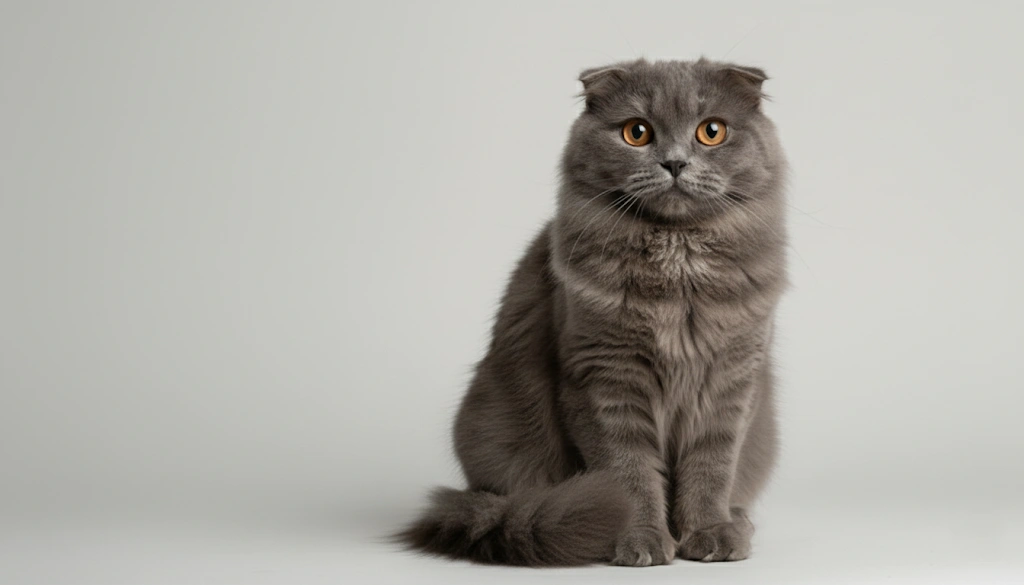
Older cats often lose appetite, muscle mass, and kidney efficiency. At this stage, food becomes more about gentle support than growth.
Helpful nutrients for seniors:
- Highly digestible protein to protect muscles.
- Controlled phosphorus for kidney health.
- Omega-3 oils to ease inflammation and support joints.
- Antioxidants (vitamins E & C) to protect aging cells.
Feeding tips:
- Offer 2–3 smaller, softer meals daily.
- Look for labels that say “senior” or “kidney care.”
- Budget about RM150–300 per month, with costs varying if prescription diets are needed.
✨ Takeaway for Malaysian cat parents
Your cat’s age should guide your food choices just as much as budget and convenience. Kittens need fuel for growth, adults thrive on balance, and seniors deserve gentle diets that protect their kidneys and joints. Choosing wisely—whether from supermarkets, pet shops, or Shopee—helps keep your furry companion healthy at every stage of life.
Cat Feeding Guide by Life Stage: Kitten, Adult & Senior
Cats have different nutrition needs as they grow. Kittens need food that supports fast growth, adults require balanced meals to prevent weight gain, and seniors benefit from gentle diets that protect their kidneys and joints.
Key Nutrient Needs by Life Stage
| Life Stage | Protein & Fat | Energy (kcal/kg/day) | What It Supports |
|---|---|---|---|
| 🐱 Kitten | ≥30% protein, ≥9% fat | 60–70 | Healthy bones, playful growth, brain development (DHA) |
| 🐈 Adult | ≥26% protein, 9–15% fat | 40–50 | Weight balance, energy for daily play, heart health (Taurine) |
| 🐈⬛ Senior | ≥26% digestible protein, 9–12% fat | 35–45 | Kidney care, joint comfort, protection from aging stress (Omega-3, antioxidants) |
💡 Friendly Tip:
- Kittens: Food is their fuel for strong growth and endless play.
- Adults: Keep meals balanced to stay fit and active.
- Seniors: Choose softer, nutrient-rich diets that support healthy aging.
👉 Next, we’ll explore special diets & medical needs, for cats with sensitive digestion, urinary issues, or other health concerns.
Sensitive Stomach Cat Food (Malaysia)
While AAFCO or FEDIAF-compliant maintenance diets cover the needs of healthy cats, some situations require special veterinary diets. These are not just marketing labels—they are medical tools designed to help cats with gastrointestinal, urinary, skin, or metabolic problems.
Sensitive Stomach & Digestive Support
Cats with ongoing vomiting, diarrhea, or food intolerance may benefit from diets made for sensitive stomachs. These are also useful for post-antibiotic digestive imbalance or inflammatory bowel disease (IBD).
Key diet features
- Hydrolyzed or novel proteins for easier digestion
- Added prebiotics and fiber to support gut microbiota
- Controlled fat to reduce digestive stress
📌 Reference: Hall et al., JFMS (2020) – Nutritional management of GI disease
Urinary Health Diets: Preventing Stones & Infections

Urinary problems are common in Malaysian cats, especially those with Feline Lower Urinary Tract Disease (FLUTD) or urinary stones.
Key diet features
- Controlled magnesium and phosphorus to limit crystal formation
- Adjusted urine pH to prevent struvite stones
- Increased moisture and sodium to promote hydration and urination
📌 Reference: Buffington et al., JAVMA (2019) – FLUTD nutrition management
Food Allergies & Skin Issues
Food allergies can cause itching, dermatitis, chronic ear infections, or digestive upset. Special diets reduce exposure to allergens.
Key diet features
- Hydrolyzed protein or novel protein (e.g., duck, venison, rabbit)
- Limited-ingredient recipes to minimize triggers
- Omega-3 fatty acids for anti-inflammatory support
📌 Reference: Verlinden et al., Vet Dermatol (2018)
Obesity & Weight Management
Around 50–60% of cats worldwide are overweight, and Malaysia is no exception. Obesity raises the risk of diabetes, arthritis, and fatty liver disease.
Key diet features
- High protein, calorie-controlled formulas to protect muscle mass
- Added fiber for satiety
- L-carnitine to support fat metabolism
📌 Reference: German et al., JSAP (2016) – Feline obesity interventions
Normal vs Veterinary Diets
| Condition | Normal Cat Food (Maintenance) | Veterinary / Medical Diet | Clinical Goal |
|---|---|---|---|
| Sensitive Stomach | Standard protein, moderate fat | Hydrolyzed/novel protein, added fiber, lower fat | Reduce vomiting/diarrhea, improve absorption |
| Urinary Health | Balanced AAFCO nutrients | Controlled minerals, urine acidification, higher moisture | Prevent stones & crystals |
| Allergies | Mixed proteins, grains common | Hydrolyzed/novel protein, limited ingredients | Minimize allergen exposure, reduce itching |
| Obesity | 40–50 kcal/kg/day, moderate protein | High protein, high fiber, calorie-restricted | Safe weight loss, protect lean muscle |
Vet Guidance for Special Cat Diets
Special veterinary diets can be life-saving for cats with health issues, but they should only be used under veterinary guidance. Using the wrong formula may make a condition worse:
- Urinary diets: Some acidify the urine to prevent struvite stones, but overuse can increase the risk of oxalate stones.
- Weight-loss diets: If too restrictive, they may cause liver problems such as hepatic lipidosis.
👉 Why it matters: When prescribed correctly, nutritional therapy is as important as medicine in treating cats with sensitive stomachs, urinary problems, skin allergies, or obesity.
In Malaysia, many of these diets are available through veterinary clinics, pet shops, and online platforms like Shopee or Lazada. Always check with your vet before switching your cat to a prescription formula.
How to Read Cat Food Labels
Cat food packaging often looks more like marketing than clear nutrition information. To make the best choice for your cat, Malaysian pet owners need to understand both regulatory standards and common marketing tricks.
Key Things to Check on Cat Food Labels
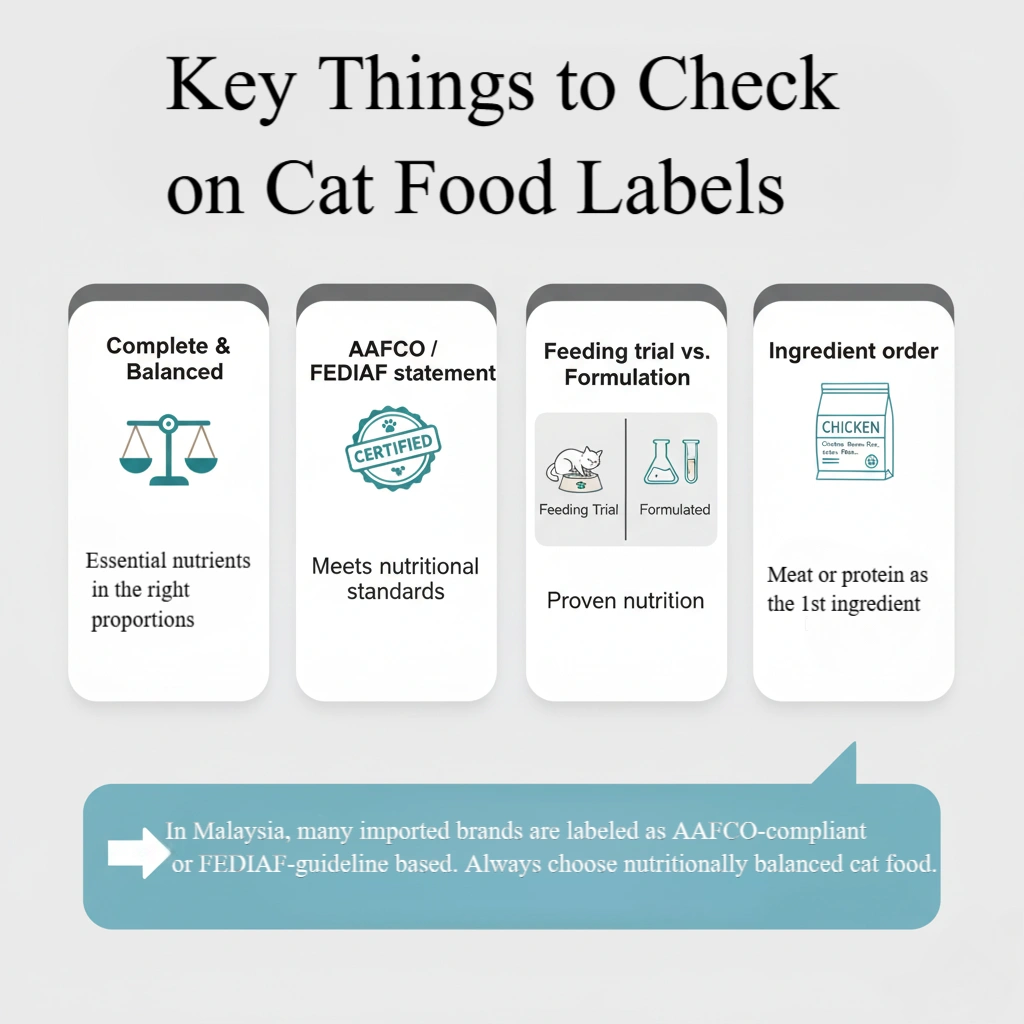
- Complete & Balanced: This phrase means the food meets the minimum nutrition standards for cats.
- AAFCO / FEDIAF statement: Most imported cat foods in Malaysia (from the US or EU) follow these standards.
- AAFCO = Association of American Feed Control Officials
- FEDIAF = European Pet Food Industry Federation
- Feeding trial vs. formulation:
- “Tested in feeding trials” = verified by real cats.
- “Formulated to meet standards” = based only on lab calculations.
- Ingredient order: Ingredients are listed by weight. Good-quality cat food usually has meat or protein as the first ingredient.
👉 In Malaysia, you will often see “AAFCO compliant” or “formulated to meet FEDIAF guidelines” on imported brands. Understanding these terms helps you avoid being misled by fancy packaging and choose truly balanced cat food—whether buying from local pet shops, veterinary clinics, or online platforms like Shopee and Lazada.
How to Read Cat Food Labels in Malaysia
Choosing the right cat food in Malaysia can be confusing because packaging often looks more like marketing than clear nutrition. By learning how to read cat food labels, you can avoid being misled and make sure your cat gets a complete and balanced diet.
1. Guaranteed Analysis (GA) – Protein, Fat, Fiber, Moisture
Every commercial cat food sold in Malaysia must show a Guaranteed Analysis (GA), usually on the side or back of the bag/can.
What to check:
| Nutrient | Minimum / Maximum | Why It Matters |
|---|---|---|
| Crude Protein | Min. 30% (dry matter) | Builds and repairs muscle, supports growth |
| Crude Fat | Min. 9–10% | Energy and essential fatty acids |
| Crude Fiber | Max. 3–5% | Helps digestion, but too much reduces absorption |
| Moisture | ≤78% (wet food), ≤12% (dry food) | Affects calorie density and shelf life |
👉 Tip for Malaysian cat owners: Always compare protein on a dry matter basis, especially when choosing between imported wet food vs. local dry food.
2. Nutritional Adequacy Statement – “Complete & Balanced”
This is the most important part of the label.
- Complete & Balanced → Meets AAFCO or FEDIAF standards, safe as daily food.
- Intermittent or Supplemental Feeding Only → Treats, toppers, not suitable as sole diet.
- Life Stage → Check if it’s for kitten, adult, senior, or “all life stages.”
👉 If a label in Malaysia does not say “Complete & Balanced,” avoid using it as your cat’s main diet.
3. Ingredient List – What Really Matters
Ingredients are listed by weight (including water). This is where marketing tricks often happen:
✅ Look for: Meat or animal protein as the first ingredient.
❌ Watch out for:
- Fresh chicken vs chicken meal → “Fresh” has more water; “meal” is more nutrient-dense.
- Splitting effect → Corn, corn gluten meal, corn flour listed separately to make meat appear first.
- By-products → Not always bad; organ meats provide taurine and micronutrients.
4. Cat Food Marketing Claims in Malaysia – Reality Check
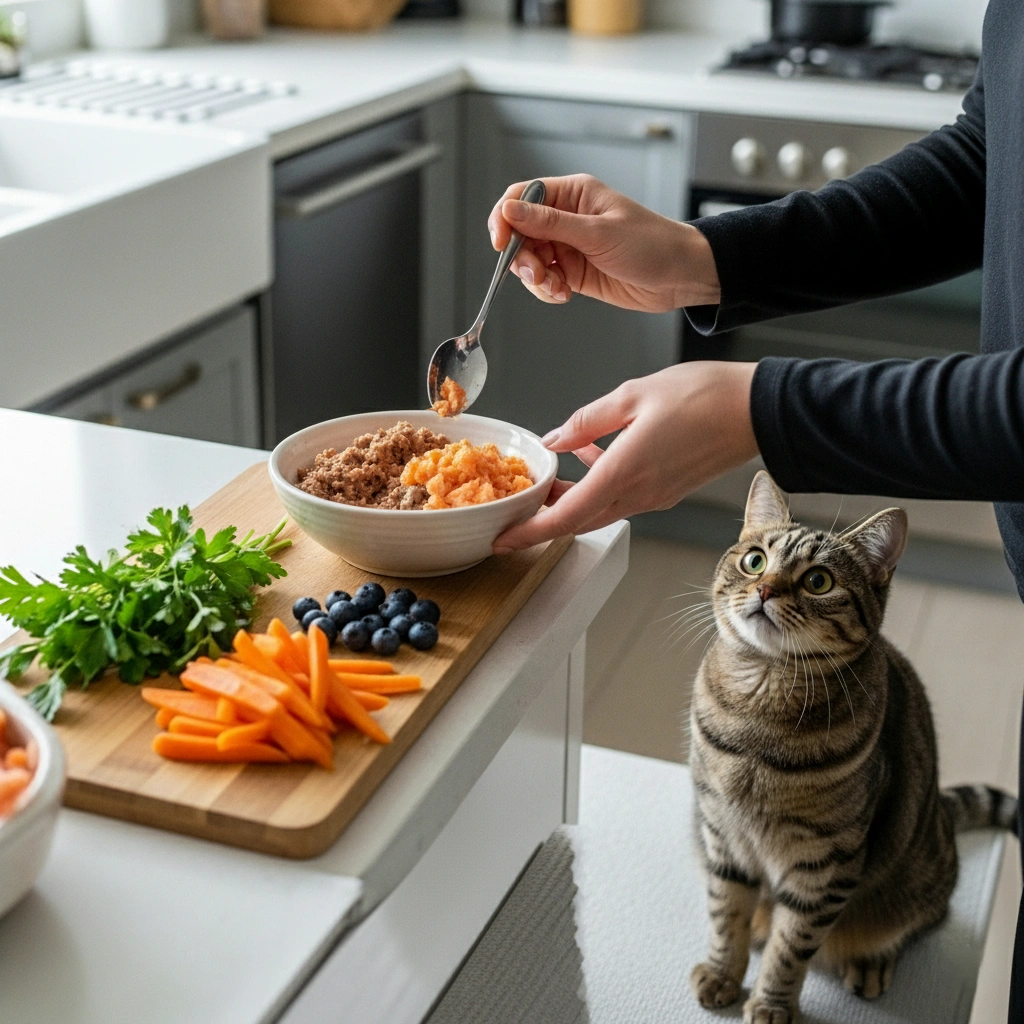
Many pet foods in Malaysia (especially on Shopee & Lazada) use trendy claims. Here’s what they actually mean:
| Label Claim | What It Means | Reality for Cats |
|---|---|---|
| Grain-Free Cat Food | Uses peas/potato instead of rice/corn | Still carbs, not automatically healthier |
| Human-Grade | Ingredients safe for humans | No official pet standard in Malaysia |
| Natural | Minimally processed | Still allows preservatives like tocopherols |
| Veterinarian Recommended | Supported by some vets | No universal rule; may be brand-sponsored |
👉 Always check if the food is AAFCO or FEDIAF compliant, not just relying on these claims.
5. Calorie Content – Feeding the Right Amount
Labels must show calories (kcal/kg). This helps calculate daily feeding.
Example for Malaysia indoor cats:
- Food: 3,800 kcal/kg
- Cat: 4 kg adult (moderate activity) → Needs ~200 kcal/day
- Feeding: ~52 g/day (based on kcal/g)
👉 Use this to avoid overfeeding, which is a common issue among Malaysian indoor cats.
6. Quick Label Checklist for Malaysian Cat Owners
| Label Section | What to Check | Expert Tip |
|---|---|---|
| Guaranteed Analysis | Protein ≥30% (dry matter), Fat ≥9% | Compare wet vs dry on dry matter basis |
| Nutritional Adequacy | Must say “Complete & Balanced” | Avoid products without this claim |
| Ingredients | Animal protein as first ingredient | Ignore “grain-free” hype, focus on protein quality |
| Calorie Content | kcal/cup or kcal/can | Match to 40–50 kcal per kg body weight |
Key Takeaway for Malaysia
The best cat food is not the one with the fanciest marketing words, but the one that is:
- AAFCO/FEDIAF compliant
- Complete & Balanced for your cat’s life stage
- Protein-rich, with clear ingredients
👉 Next time you shop in Malaysia (pet store, Shopee, or Lazada), flip the bag or can and check these sections before buying.
Cat Feeding Guide Malaysia: Calories, Portions & Practical Tips
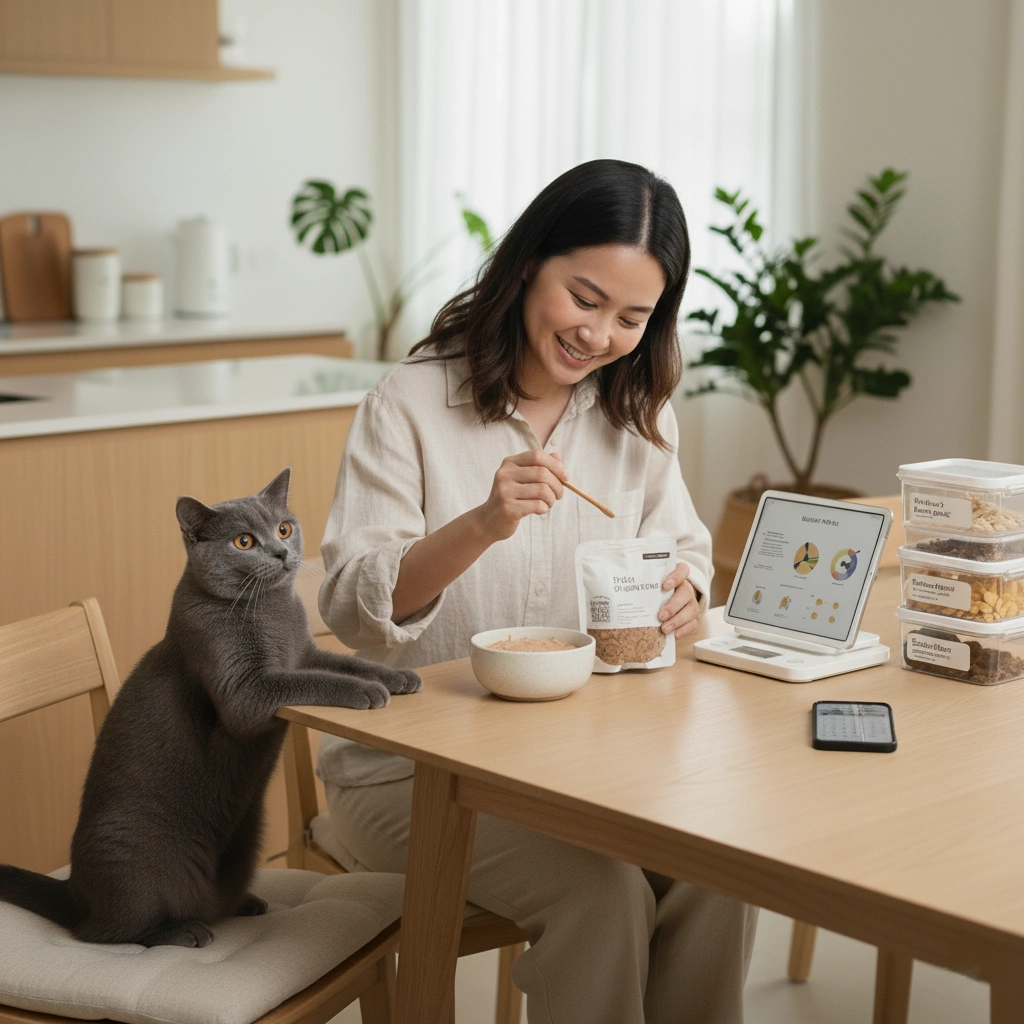
Feeding your cat is more than just filling a bowl. It requires balancing calories, portion size, meal frequency, and safe transition between foods. In Malaysia, where indoor lifestyles and hot weather affect cats’ needs, feeding mistakes can quickly lead to obesity, dehydration, or digestive issues.
1. How Many Calories Does a Cat Need Daily?
Cats’ calorie needs are based on Resting Energy Requirement (RER) and activity level.
📌 Formula:
RER = 70 × (Body Weight in kg)^0.75
Then multiply by life stage/activity factor:
| Cat Type | Multiplier | Example (4 kg cat) |
|---|---|---|
| Indoor adult (neutered) | 1.2–1.4 × RER | ~180–200 kcal/day |
| Active adult (outdoor) | 1.6–2.0 × RER | ~220–280 kcal/day |
| Kitten (<6 months) | 2.5 × RER | ~450 kcal/day |
| Senior (10+ years) | 1.0–1.2 × RER | ~150–170 kcal/day |
👉 Quick tip: Most Malaysian indoor cats need about 40–50 kcal per kg body weight per day.
2. How Many Times Should You Feed Your Cat Per Day?
Feeding frequency should reflect cats’ natural hunting patterns—small, frequent meals.
| Life Stage | Recommended Frequency | Notes |
|---|---|---|
| Kitten (<6 months) | 4–5 meals/day | Small stomachs, high energy |
| Adult (1–7 years) | 2–3 meals/day | Portion control prevents obesity |
| Senior (10+ years) | 2–3 smaller meals/day | Easier to digest |
| Free Feeding (dry only) | Not recommended | Linked to obesity |
👉 In Malaysia, where many cats are kept indoors and sterilised, controlled portion meals are better than free feeding.
3. How to Change Cat Food Safely (7–10 Days)
Sudden diet switches may cause vomiting or diarrhea. Always transition gradually:
| Day | Old Food | New Food |
|---|---|---|
| 1–2 | 75% | 25% |
| 3–4 | 50% | 50% |
| 5–6 | 25% | 75% |
| 7–10 | 0% | 100% |
👉 If your cat shows signs of GI upset, stay at the current ratio for a few more days.
【图表推荐:transition percentage 曲线】
4. How to Check If Your Cat Is Overweight (BCS Scale)
The Body Condition Score (BCS) system (1–9 scale) is used by vets worldwide:
| Score | Description | Health Risk |
|---|---|---|
| 1–3 | Ribs visible, very little fat | Underweight → malnutrition risk |
| 4–5 | Ribs palpable, waist visible | Ideal weight |
| 6–7 | Ribs hard to feel, waist absent | Overweight → diabetes, arthritis |
| 8–9 | Heavy fat deposits, no waist | Obese → high disease risk |
👉 Try the “rib test”: your cat’s ribs should feel like pens under a thin cloth, not buried in fat.
5. Hydration & Feeding Environment
Cats are naturally poor drinkers. In Malaysia’s hot climate, dehydration is a common risk.
✅ Provide wet food or a cat water fountain.
✅ Feed in a quiet area, away from the litter box.
✅ Multi-cat homes: prepare multiple bowls to avoid food guarding.
Key Takeaways for Malaysian Cat Owners
- Indoor cats need about 40–50 kcal per kg/day.
- Kittens = frequent meals; adults = portion control; seniors = smaller meals.
- Transition food gradually over 7–10 days.
- Use BCS scoring instead of relying only on packaging.
- In Malaysia’s hot climate, hydration is just as important as calories.
FAQs About Cat Food & Nutrition
Q: Can cats eat dog food in Our country?
A: No, cats cannot eat dog food. It lacks taurine, vitamin A, and arachidonic acid, which may cause blindness or malnutrition.
👉 Our country, dog food is cheaper in supermarkets, but it should never replace complete & balanced cat food.
Q: Can cats in Our country be vegetarian or vegan?
A: No, cats cannot live on vegetarian or vegan diets. They need taurine and other nutrients only found in animal protein.
👉 Even if plant-based cat food is sold on Shopee or Lazada, it is unsafe without strict veterinary guidance.
Q: Can cats drink milk in Malaysia’s tropical climate?
A: Most cats are lactose intolerant, and cow’s milk often causes diarrhea.
👉 In Malaysia’s hot weather, fresh water and wet cat food are the best hydration sources. Special lactose-free cat milk from pet shops is safe in small amounts.
Q: How often should I feed my cat in Our country?
A: Kittens need 4–5 meals/day, adults 2–3 meals/day, and seniors 2–3 smaller meals/day.
👉 Free-feeding dry kibble is common in Malaysia but linked to obesity, so portion control is a healthier choice for indoor cats.
Q: Is grain-free cat food better for cats in Our country?
A: Not always. Grain-free diets often replace rice with peas or potato, which still add carbs.
👉 Grain-free brands are popular on Shopee and Lazada, but protein quality and complete & balanced nutrition matter more than marketing.
Q: How do I know if cat food is good quality in Malaysia?
A: Look for a “Complete & Balanced” label (AAFCO/FEDIAF), at least 30% protein (dry matter), and named animal protein as the first ingredient.
👉 cat owners should check feeding trials or vet endorsements before buying online.
🐾 Conclusion & Next Steps
Feeding your cat in Malaysia isn’t just about filling up the food bowl — it’s really a form of preventive healthcare. The right diet can lower the risk of obesity, diabetes, kidney problems, and even dental disease, while keeping your cat active, strong, and happy for years.
From this guide, you’ve learned:
- Why cats need species-specific nutrition (nutrients like taurine, vitamin A, and arachidonic acid that aren’t in dog food or plant diets).
- The pros and cons of different food types — dry kibble, wet food, raw, and homemade.
- How nutrition needs change at different life stages: kitten, adult, and senior.
- When special diets are necessary for sensitive stomachs, urinary health, allergies, or weight control.
- How to read food labels critically instead of falling for buzzwords like “grain-free” or “natural.”
- Practical feeding tips: calorie calculation, feeding frequency, safe food transitions, and checking your cat’s body condition score (BCS).
- Clear, evidence-based answers to the most common questions Malaysian cat owners ask.
🐱 What You Can Do Next
✅ Got a new kitten? → Start with our Kitten Food Guide and Vaccination Schedule in Malaysia to build a strong foundation.
✅ Caring for adult cats? → Learn about indoor feeding tips and how to prevent common illnesses in hot, humid climates.
✅ Looking after a senior cat? → Read our Senior Cat Nutrition tips and guides on joint care and weight management.
✅ Worried about special health issues? → Check our guides on sensitive stomach cat food, food allergies, and whether grain-free diets are really worth it.
💡 Key takeaway:
Here in Malaysia, what you put in your cat’s bowl isn’t just food — it’s the easiest way to keep them healthy. Every crunch of kibble or lick of wet food adds up to more happy, healthy years together.
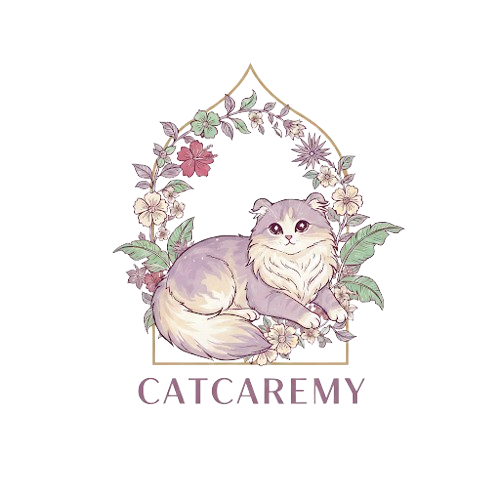
[…] Cat Nutrition Guide for Malaysia […]
[…] Malaysian Cat Nutrition & Digestive Health Guide […]
[…] just feeding and grooming — emergencies can happen anytime. From accidental falls to poisoning, Malaysian cat owners face unique challenges. This 2025 guide provides practical, Malaysia-focused first aid advice so you can act fast and save […]